Cataloger's
Reference Shelf
Library of Congress Rule Interpretations
1.0E. Language and script of the description
When applicable, apply these guidelines, including the use of brackets, to headings.
Table of Contents:
Matter That Cannot Be Reproduced by the Facilities Available
Special Letters, Diacritical Marks, and Punctuation Marks
![]()
Do not attempt to replicate font features such as bold and italic (e.g., when used to indicate a scientific name) through the use of underlining or other means of indicating such features.
In general, transcribe letters as they appear in the source. However, convert earlier forms of letters and earlier forms of diacritical marks into their modern form, as specified herein. If there is any doubt as to the correct conversion of elements to modern forms, transcribe them from the source as exactly as possible. (See also the section on Special Letters, Diacritical Marks, and Punctuation Marks.)
The following represent a special case: u/v, uu, or vv/w. When these letters are used in Latin and some other languages without regard to their vocalic or consonantal value, so that "u" is used for a "v," etc., the transcription should be regularized. This means that for the bibliographic description of items published after 1800,
1. use v for consonants, e.g., vox, Victoria;
2. use u for vowels, e.g., uva, Ursa Major;
3. use w for consonantal uu or vv, e.g., Windelia.
Follow this guide also for publications of any date when the case is not one of bibliographic description, e.g., headings or citations from reference works.
The letters i/j should be handled differently. For the bibliographic descriptions of items published after 1800, transcribe "i" and "j" as they appear; do not attempt any regularization. PCC practice: Follow this stipulation also for uniform titles for series.
For any other case of headings, citations from reference sources, etc.,
1. use j for consonants, e.g., jus, Julius;
2. use i for vowels, e.g., iter, Ilias.
N.B. For the transcription of any of these letters in bibliographic description for pre-1801 publications, apply Descriptive Cataloging of Rare Materials (Books) (DCRM(B)). For the use of uniform titles, so that DCRM(B) titles file properly (i.e., together with the titles of post-1800 publications), see LCRI 25.1.
Matter That Cannot Be Reproduced by the Facilities Available
The rule, in effect, requires as much fidelity to the source as the technical capacity within the cataloging agency will allow. It recommends a "cataloguer’s description in square brackets" for any "matter that cannot be reproduced by the facilities available." Generally, this is a practicable solution, but there are special instances in which doing other than describing the matter is appropriate. The main purposes of these instructions are to categorize all the methods to be employed, including a "cataloguer’s description," and to give specific directions for each in terms of the particular character set phenomenon encountered.
In the context of machine-readable catalog records note that as used in 1.0E and in the preceding paragraph, "facilities available" means the totality of characters that can be represented in machine-readable form and displayed/printed (known as the "MARC-8 character set"; referred to hereafter as the "character set"). These characters can also be represented in the UCS/Unicode UTF-8 character set, but the guidelines in this LCRI apply only to that subset of the Unicode UTF-8 set that has a counterpart in MARC-8, i.e., the MARC repertoire of UTF-8. Conventions appropriate to particular character set situations have been developed as follows:
Special Marks of Contraction (e.g., older printed Latin)
Special Letters, Diacritical Marks, and Punctuation Marks
Apply the appropriate conventions described in the sections below. As judged appropriate, use notes to explain and added entries to provide additional access. In the special provisions below, notes are suggested as possible models for form, not to require the use of the note.
If the super/subscript placement of a character is not essential to avoid serious distortion or loss of intelligibility (e.g., ![]() ,
, ![]() ,
, ![]() ), record the super/subscript character on the line in the regular manner (e.g., no., 2e). If a period is associated with the super/subscript letter (e.g.,
), record the super/subscript character on the line in the regular manner (e.g., no., 2e). If a period is associated with the super/subscript letter (e.g., ![]() ) and the characters are the abbreviation of a single word, record the period as the last element (e.g., Ma.). In case of serious distortion or loss of intelligibility, record the character in super/subscript position for all such characters available in the character set, namely, Arabic numerals (0-9), the minus sign ( - ), parentheses ( ( ) ), and the plus sign ( + ). In all other cases use the double underscore convention described in the section on Special Letters, Diacritical Marks, and Punctuation Marks. Give the letter being represented in upper or lower case according to the source.
) and the characters are the abbreviation of a single word, record the period as the last element (e.g., Ma.). In case of serious distortion or loss of intelligibility, record the character in super/subscript position for all such characters available in the character set, namely, Arabic numerals (0-9), the minus sign ( - ), parentheses ( ( ) ), and the plus sign ( + ). In all other cases use the double underscore convention described in the section on Special Letters, Diacritical Marks, and Punctuation Marks. Give the letter being represented in upper or lower case according to the source.
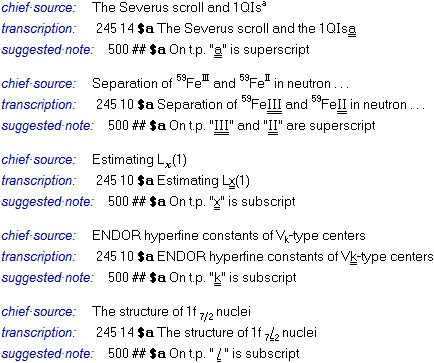
In roman script records romanize all occurrences of Greek letters (with the exception below) regardless of the facilities available (the intent is to assist filing and searching even though there are characters for alpha, beta, and gamma in the character set and certain Greek capital letters are identical to their roman equivalents). If the context shows that a Greek letter or letters is used to represent a letter in the International Phonetic Alphabet, however, see the section on Special Letters, Diacritical Marks, and Punctuation Marks.
Exception: If the Greek letter appears separately, give the name of the letter in the language of the context (if unknown in the language of the context, use English) enclosed within brackets. For searching purposes, insure that the bracketed interpolation is not connected with other letters. Thus, if no space appears in the source on either side of the Greek letter, put a space on either side of the bracketed interpolation, except when this interpolation is already distinct from adjacent letters by the presence of characters that serve as separators. N.B. This provision is necessary, because brackets do not serve as separators for searching purposes. ( FN 1)
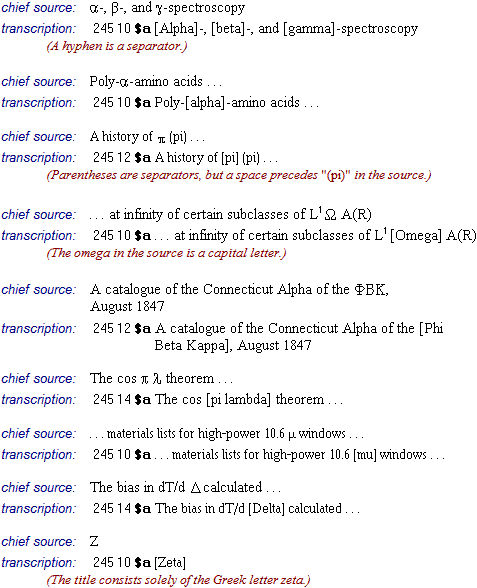
When a Greek letter is used in a word that is otherwise in the roman alphabet in the source, use the romanized form of the letter (instead of its name) in brackets.

(The letter in this example is from the International Phonetic Alphabet; therefore, the double underscore convention is used (cf. the section on Special Letters, Diacritical Marks, and Punctuation Marks).)
When special marks of contraction have been used by the printer in continuance of the manuscript tradition, expand affected words to their full form, enclosing supplied letters within brackets.

Do not expand conventional abbreviations in which a period follows a letter or letters. However, when an abbreviation standing for an entire word appears in the source, record instead the word itself, enclosing it in brackets, e.g., "... amico[rum] [et] ..." When the meaning of an abbreviation or contraction cannot be determined, substitute a question mark within brackets for each element in question, e.g., "... amico[?] [?] ..." When the meaning of an abbreviation or contraction is conjectural, use the question mark after the supplied letters or word within the same set of brackets, e.g., "...amico[rum?] ..."
When titles are "expanded," title added entries may be generated by the first indicator in the 245 field . The added entry will be exactly the same as the title proper (including the brackets around letters). To express a title added entry in any other form, use a 246 field .
246 3# $a Breviarium monasticum secundum ritum et morem monachorum Ordinis Sancti Benedicti de observantia Casinensis Congregationis
Special Letters, Diacritical Marks, and Punctuation Marks
Use the double underscore (![]() ) as the conventional means of signaling special letters (including superscript and subscript letters), diacritical marks, and punctuation marks for which there is no exact representation in the character set. Use the double underscore with the nearest roman equivalent in cases in which the roman equivalent is obvious, e.g.,
) as the conventional means of signaling special letters (including superscript and subscript letters), diacritical marks, and punctuation marks for which there is no exact representation in the character set. Use the double underscore with the nearest roman equivalent in cases in which the roman equivalent is obvious, e.g., ![]() . When the nearest roman equivalent is not obvious or there is doubt that it is obvious, it is necessary to establish the equivalent, after which the list of equivalencies will be updated. The equivalencies below have been established to date, mostly from the International Phonetic Alphabet (IPA). Note that the IPA uses some Greek letters; when it is judged by the context (usually some form of linguistic study) that the Greek letter probably derives from its use in the IPA, use the double underscore convention or the equivalency indicated below, not the convention for Greek letters given above.
. When the nearest roman equivalent is not obvious or there is doubt that it is obvious, it is necessary to establish the equivalent, after which the list of equivalencies will be updated. The equivalencies below have been established to date, mostly from the International Phonetic Alphabet (IPA). Note that the IPA uses some Greek letters; when it is judged by the context (usually some form of linguistic study) that the Greek letter probably derives from its use in the IPA, use the double underscore convention or the equivalency indicated below, not the convention for Greek letters given above.

Note that the use of the double underscore convention does not always insure a one-for-one equivalency; the intent, instead, is to signal those cases in which the character used in the catalog record is not an exact replication of the character in the source.
Exception: Do not use the double underscore convention in the following cases; use instead the equivalent indicated:
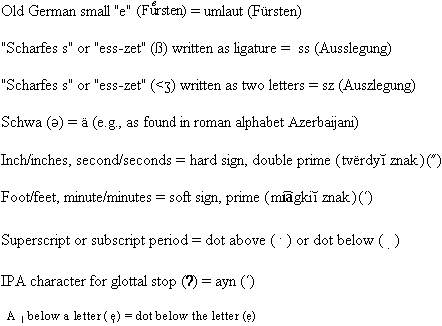
The objective in treating signs and symbols not represented in the character set is to render or convey the intention without undue time and effort and with a minimum of interpolation, using one of the techniques described in this section. Note that a minimum of interpolation is wanted because those searching the machine catalog cannot very often be expected to "second-guess" the cataloger in this respect, i.e., users will normally formulate search queries that necessarily do not take interpolations into account. As judged appropriate, use notes to explain and added entries to provide additional access; the examples below are illustrative, not prescriptive.
1. If the symbol is judged not to be a integral or essential part of the title, do not intervene in the transcription. Instead, omit the symbol; explain its presence in a note if it is judged worth mentioning.
transcription: 245 10 $a "W" today! Tomorrow?
(On the title page the traditional female symbol appears under the letter "W" but the preface makes it clear that the symbol is not intended to form part of the title and gives the full title.)
suggested note: 500 ## $a On t.p. the symbol for female appears under the letter "W"
added entry: 246 30 $a Women today! Tomorrow?
2. Use existing characters when this can be done without serious distortion or loss of intelligibility.
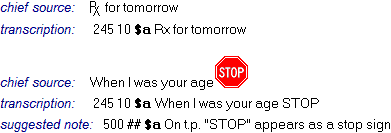
3. Use the double underscore convention (cf. the section Special Letters, Diacritical Marks, and Punctuation Marks.)

4. Substitute in the language of the context the word, phrase, etc., that is the obvious spoken/written equivalent (if unknown in the language of the context, use English); bracket the interpolated equivalent. If the element in the source is not preceded or followed by a space, in general precede or follow the bracketed interpolation by a space unless the preceding or following character in the source is itself also a separator or unless the use of a space would create an unintended result for searching.
chief source: I ![]() a piano
a piano
transcription: 245 10 $a I [love] a piano
suggested note: 500 ## $a On t.p. "[love]" appears as a heart
chief source: A study of the ![]()
transcription: 245 12 $a A study of the [ankh]
suggested note: 500 ## $a On t.p. "[ankh]" appears as the ankh symbol
chief source: Poe![]() and free verse
and free verse
transcription: 245 10 $a Poe[try] and free verse
(The interpolation is not preceded by a space because that would create two words for searching (brackets are not separators).)
suggested note: 500 ## $a On t.p. "[try]" appears as an illustration in the form of a tree
chief source: Tinglysningslovens §38
transcription: 245 10 $a Tinglysningslovens [paragraf] 38
chief source: Dokumentation der politischen Geschichte zur Reform des §144 STG
transcription: 245 10 $a Dokumentation der politischen Geschichte zur Reform des [Paragraphen] 144 STG
chief source: ... proposed rules governing §2255 proceedings ...
transcription: 245 10 $a ... $b ... proposed rules governing [section] 2255 proceedings ...
chief source: Roman Opalka : 16 Details aus dem Werk 1965/1-∞
transcription: 245 10 $a Roman Opalka : $b 16 Details aus dem Werk 1965/1-[unendlich]
suggested note: 500 ## $a On t.p. "[unendlich]" appears as the infinity symbol
chief source: Opalka 1965/1-∞ : 9 juin-9 juillet 1982
transcription: 245 10 $a Opalka 1965/1-[l'infinité] : $b 9 juin-9 juillet 1982
suggested note: 500 ## $a On t.p. "[l'infinité]" appears as the infinity symbol
chief source: The added mass coefficient of a cylinder oscillating in shallow water in the limit K→0 and K∞
transcription: 245 14 $a The added mass coefficient of a cylinder oscillating in shallow water in the limit K --> 0 and K [infinity]
(The arrow is input as two hyphens and an angle bracket.)
suggested note: 500 ## $a On t.p. "[infinity]" appears as the infinity symbol
Exception 1: Do not transcribe characters that indicate birth (e.g., an asterisk) or death (e.g., a dagger) even if such characters are in the character set. Do not use a mark of omission; instead, explain the omission in a note.
chief source: In honor of Saint Basil the Great ![]() 379
379
transcription: 245 10 $a In honor of Saint Basil the Great 379
suggested note: 500 ## $a On t.p. "379" is preceded by a dagger
chief source: Walter : *1926![]() 1945 an der Ostfront
1945 an der Ostfront
transcription: 245 00 $a Walter : $b 1926 1945 an der Ostfront
suggested note: 500 ## $a On t.p. "1926" is preceded by an asterisk; "1945" is preceded by an Iron Cross
Exception 2: Ignore symbols indicating trademark (registered or otherwise), patent, etc. These include a superscript or subscript "R" enclosed in a circle ( ® ) (ignore although included in the character set) and the superscript or subscript letters "TM" ( ä). Do not explain their presence in a note. (Ignore such symbols also when they appear with elements used in headings.)
chief source: The Gumby® books of letters
transcription: 245 14 $a The Gumby books of letters
If the spoken/written equivalent is not obvious or if there is doubt that it is obvious or if it is unknown, give an explanation or a description in the language of the context (if unknown in the language of the context, use English).
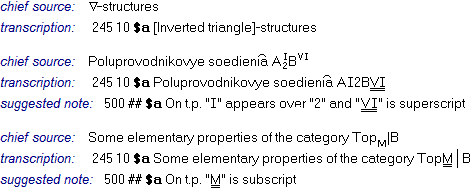
If a title consists solely of a sign or symbol or one or more marks of punctuation, provide an equivalent in all cases, even if the particular symbol is itself in the character set.
chief source: ![]() / Gregory Corso
/ Gregory Corso
transcription: 245 10 $a [Ankh] / $c Gregory Corso
suggested note: 500 ## $a The title consists solely of the ankh symbol
chief source: + : [novellaciklus] / Czakó Gábor
transcription: 245 10 $a [Plusz : $b novellaciklus] / $c Czakó Gábor
("+" is in the character set.)
suggested note: 500 ## $a The title consists solely of a plus sign
chief source: © / Free Spirits, Inc.
transcription: 245 10 $a [Copyright] / $c Free Spirits, Inc.
("©" is in the character set.)
suggested note: 500 ## $a The title consists solely of the copyright symbol
chief source: ---- / Edvardas Gudavičius
transcription: 245 10 $a [Keturi brūkšniai] / $c Edvardas Gudavičius.
suggested note: 500 ## $a The title consists solely of four hyphens
but
chief source: ????? Steele's answers, by Daniel Steele ...
transcription: 245 10 $a ????? Steele's answers / $c by Daniel Steele ...
(Although the title begins with marks of punctuation, it also contains indexable data and no special intervention is required.)
See also: